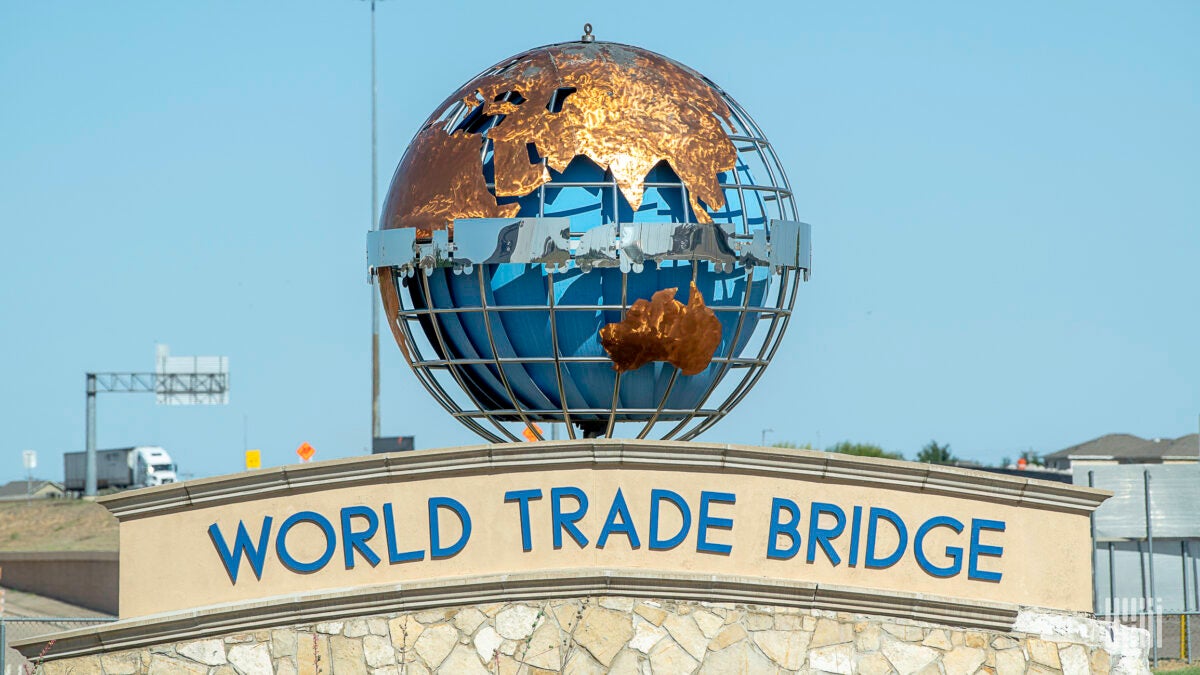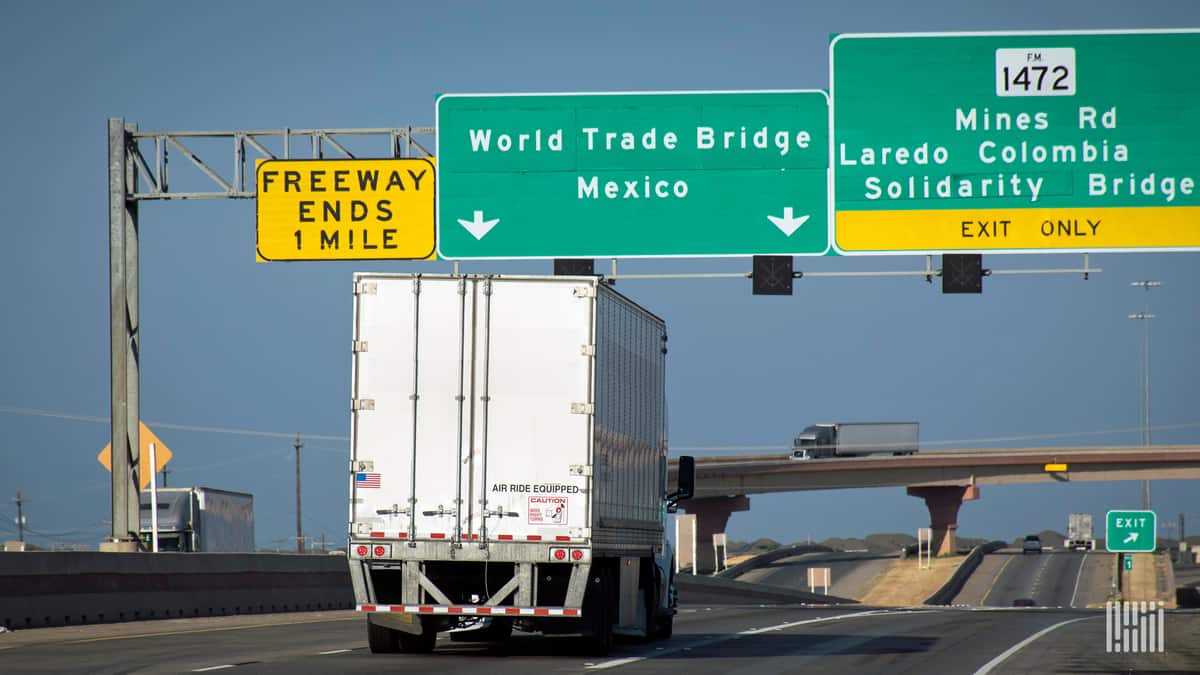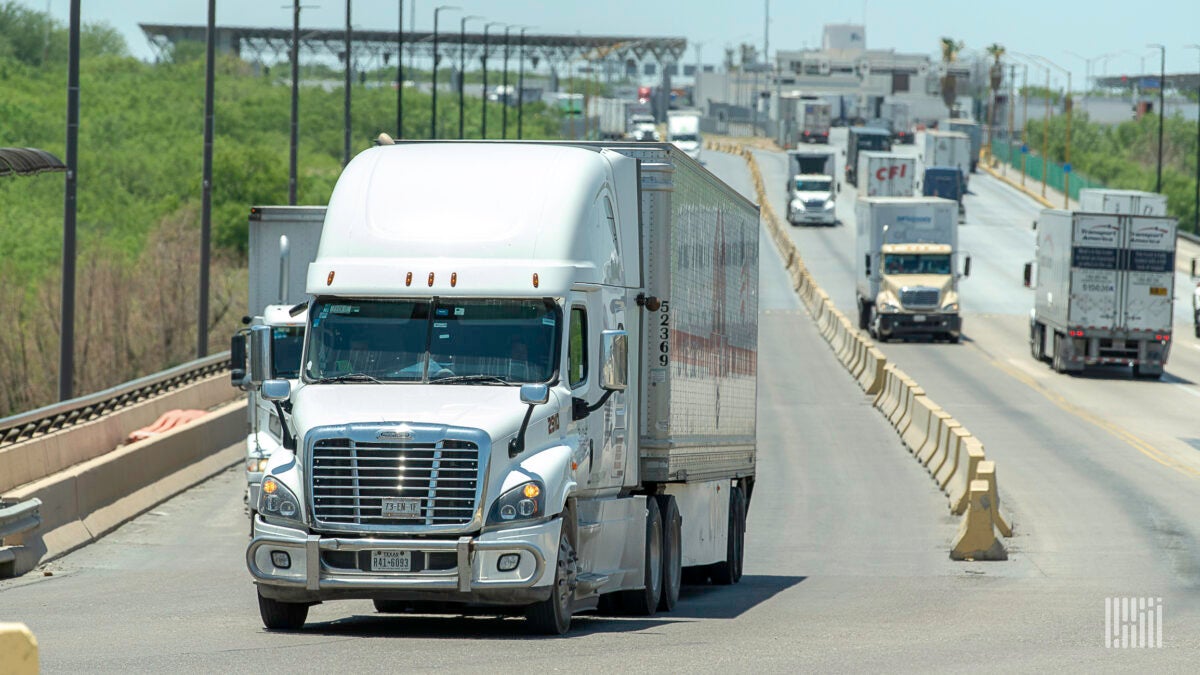As more global supply chains shift manufacturing to Mexico, cross-border operators said nearshoring will be a key economic driver for the North American freight economy in 2024.
Nearshoring — the relocation of production and manufacturing operations from one country to another to be closer to end consumers — has fueled manufacturing growth across Mexico as shippers look for supply chains that are closer, cheaper and more favorable to doing business with the U.S.
One of the largest nearshoring projects headed to Mexico will be Tesla’s $5 billion automotive factory in Monterrey, which is scheduled to be completed within the next two years.
The increased focus on bringing supply chains back to North America helped Mexico replace China as the top U.S. trading partner in 2023. Mexico has been the top U.S. trading partner since the beginning of the year, reporting $656 billion in two-way trade from January through November, according to the U.S. Census Bureau.
FreightWaves recently spoke with trade professionals who mostly remain bullish about the prospect of U.S.-Mexico cross-border freight flows next year. They also discussed nearshoring, cargo capacity and hot commodities in 2024. Trade professionals interviewed include:
- Jordan Dewart, president of 3PL Redwood Mexico.
- Ed Habe, vice president of Mexico sales for cross-border LTL carrier Averitt Express.
- Deepak Chhugani, founder and CEO of cross-border technology platform Nuvocargo.
- Mike Hamill, vice president of strategy for the transportation division at Trimble.
More freight will flow between the US and Mexico in 2024
Dewart: “What we’re seeing is certainly … foreign direct investment is still pouring into Mexico. Just every single day, multiple companies are announcing either brand new construction or expansions of existing facilities for players that are already in Mexico. Production is coming and a lot of it is going to be coming online in 2024. We’re very, very bullish about 2024.”
Habe: “I’m bullish on Mexico in 2024. Just say even if global manufacturing were not to increase next year, just the jockeying of existing manufacturing to Mexico will represent good things, not just for Averitt, but North America in general. At Averitt, we are in a good spot. We have terminals in the southeastern U.S.. We’re also on the Texas-Mexico border. Cross-border trade is a natural positive for us.”
Chhugani: “We expect 2024 to be a year of expansion and of consolidation. For companies already trading between Mexico and the U.S., we’re seeing accelerated expansions into more facilities and new commodities in their supply chain. And for companies new to trade across the U.S. and Mexico, we’re seeing more and more entrants consolidating their positions and committing to this trade lane long term. For us this has translated into an opportunity to help companies take their first steps into U.S.-Mexico trade and act as a key ally to set up everything — freight, customs, insurance — for them for added simplicity end to end.”
Hamill: “Many forecasts indicate there will be little to no overall growth in the freight market for 2024. There’s also a lot of uncertainty around consumer demand with very little consistency in consumer spending as it relates to specific end markets. Consumer spending has shown resilience over the past several quarters and has the ability to continue in 2024 despite interest rates, the global economy and geopolitical environment. I’m taking a neutral position related to end markets due to consumer spending patterns, which I believe will closely correlate with interest rates. I expect some opportunities for improvement in … automotive, consumer packaged goods and retail, with less opportunity in chemicals.”

Despite excess US trucking capacity, cross-border lanes may tighten
Hamill: “The capacity buildup that occurred in the market post COVID-19 lockdowns was unlike anything the industry had seen before as rates and freight volumes increased, and capacity was added on a large scale. Given this huge influx of capacity over an extended period of time, it’s taken longer than normal for that capacity to exit the market. We saw capacity leave the market throughout 2023 and will continue to see more in 2024. Because the macroeconomic outlook doesn’t support any large increase in demand, supply exiting will be the driving factor to bring capacity and freight into greater equilibrium, which I suspect will occur sometime in mid to late 2024.”
Chhugani: “As the market comes out of this bottom, we don’t expect to see Mexican carriers entering the market like they do in the U.S. Carrier supply is much more stable in Mexico, so we already know who the vast majority of the carrier base will be, and they will still face driver and equipment shortages. Freight rates will likely continue to come up as the demand increases and supply is not as elastic as a perfectly competitive market with free entry and exit would suggest.”
Dewart: “I think 2024 will absolutely take over cross-border trade. We are participating in a lot of requests for proposals, bids currently. You get to see many, many different companies, what they’re forecasting for booking for 2024. All of them are higher than what they produced in 2023. That is a forecast, of course. Then on the flip side, the carrier side, we’re not seeing any investment into growing their fleets, adding more trucks. The cross-border carrier market isn’t planning on making major investments in trucks. They’re finally taking receipt of trucks they ordered 18 months ago, but they’re just using those to reduce the age of their fleets, not adding trucks. I think the No. 1 reason is not so much on the demand side, but there’s just not enough drivers to go into these trucks in Mexico.”
Habe: “We have actual infrastructure along the border, millions of dollars in infrastructure. It’s a given that there’s going to be an impact in Mexico. How explosive will it be in the next few years? That’s the big question. Is it going to be single-digit, double-digit, triple-digit impact? I would bet on the higher side, the impact coming out of Mexico, because it just makes sense. These new economic blocs, North America and Monterrey, Mexico, is obviously the one that’s going to have and is already seeing some of the biggest impact investment-wise. I was at a conference in Mexico recently and there was a big talk about the Interstate 35 corridor, Austin, San Antonio, Laredo, and Monterrey, representing a huge impact to the U.S.”

Where cross-border loads are headed in 2024
Chhugani: “When we’re talking about loads that will thrive in 2024, it’s impossible not to highlight the automotive industry. The growth in Mexican car production is remarkable, 13.54% year on year in the first three quarters of 2023, and it’s not just the giants like GM, Ford, Nissan, VW — even smaller players in the parts and components game are set to benefit significantly. We are anticipating a surge in demand for raw materials and unfinished goods crucial for car and machinery production, especially given the highly integrated nature of the auto industry.”
Habe: “Averitt is very diversified across the board in U.S.-Mexico loads. There were times in the past where maybe we were dependent on things, especially automotive. Now we are diversified in the case of not just automotive, but foodstuffs, liquors, electronic products, office supplies — you name it, it’s getting moved cross-border nowadays.”
Dewart: “I don’t think a day goes by that we haven’t talked about a new customer, a new project that we’re working on, and it’s things like video lottery machines, or it’s some product that you never would have imagined that’s being made in Mexico. All of the big retail customers are ramping up their production in Mexico, and they’re trying to get products sourced out of Mexico, your Walmart, Home Depot, Lowe’s, Target, all of them are looking very heavily to Mexico to source products in the fast-moving consumer goods space. Looking forward into the future, companies like Google, Samsung, LG, GE, Mattel, Lego, all of those brands, almost every product they make is going to be ramped up and coming in from Mexico.”

Prospects for continued nearshoring growth in Mexico
Hamill: “As companies look to reduce costs and increase their supply chain resiliency, working with vendors and suppliers in Mexico and Latin America makes perfect sense. Momentum from investments in infrastructure continues and it’s expected that these strategies will lead to additional freight opportunities, especially in the manufacturing sector. However, cargo theft and security remain concerns in the region, while demand for warehousing and cold chain space has increased, making these things harder to find and more expensive.”
Chhugani: “I don’t see the nearshoring trend slowing down anytime soon. Foreign direct investment in Mexico is expected to grow by around 10% annually, reaching approximately $60 billion by 2027, and there are at least 495 new companies projected to enter the country between 2024 and 2025, which makes for a very promising outlook as we consider the long-term effects of this trend.”
Habe: “We saw immediate impact, especially in 2023 with companies already in Mexico, which I refer to as phase one. I’ve seen the second phase, brand new companies that have started to open up facilities, initially planning to come online this year, and now it’s been pushed off to 2024. Part of it is because of the U.S. economy; we have been getting mixed signals on the economy. I’ve been in factories in Mexico that have been built, they’re just kind of waiting to get turned on, and they don’t really have a good idea on volumes yet. The impact right now is more on existing companies that have the existing manufacturing in place, and they’re basically relocating that existing manufacturing into Mexico. The big part that everyone’s hoping for is the brand new manufacturing that everyone’s been telling me will be happening in the next year to two years.”
More articles by Noi Mahoney
Exports of Mexican-built cargo trucks fell in November







